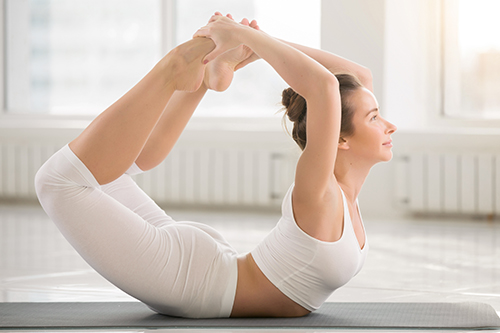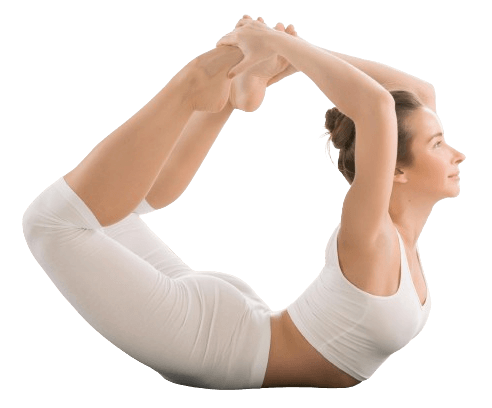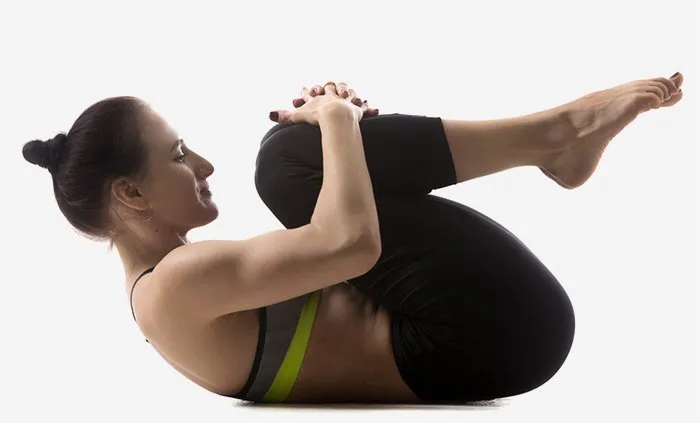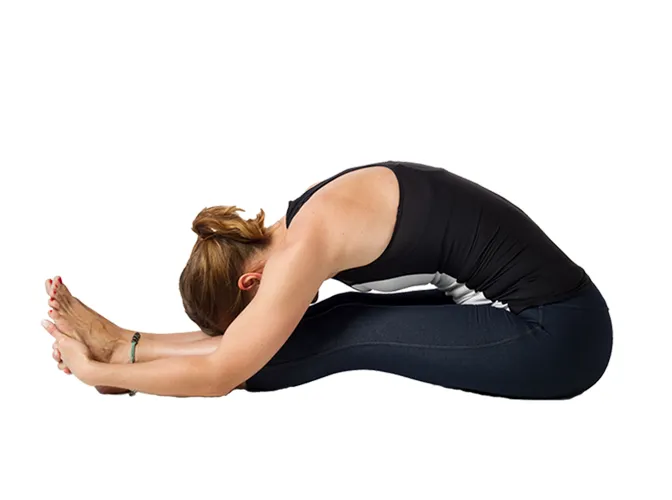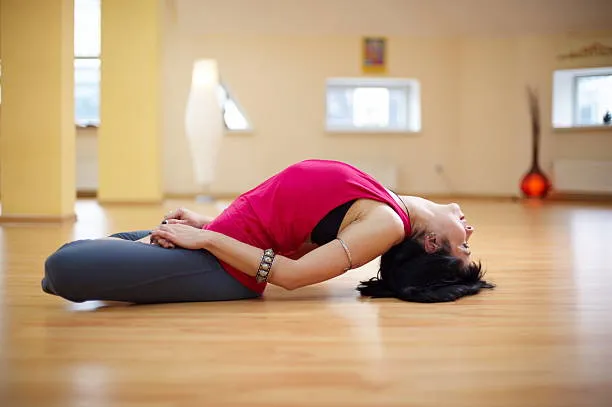On This Page
Dhanurasana – Introduction, Procedure, and Benefits
Introduction
The Sanskrit word Dhanu means a bow. Therefore, this is called “the bow pose’, because in the final pose the body resembles a bow, the trunk and thighs representing the wooden part of the bow and the lower parts of the legs and the arms representing the bowstring.
धनुरासन – इस आसन में अभ्यास करने वाले का शरीर धनुष के आकार का दिखाई देता है। इसलिए इसे धनुरासन कहते हैं। यह आसन महत्वपूर्ण अंगों पीठ तथा
पेट पर विशेष प्रभाव डालते हैं।
Hath Yoga Pradipika. 1/ 25
धनुराकर्षणं कुर्याद्नुरासनमुच्यते।।
कर्णेपर्यत॑ धनुष आकर्षणं यथा भवति तथा कुर्यात् ।गृहीतांगुष्ठ एकम प्रसारित कृत्वा गृहीतांगुष्ठमितरं पाणि कर्णपर्यतमा- कुंचितंदत्यथ: एतद्धनुरासनमुच्यते ।।
दोनों पादों के अंगूठों को हाथों से पकडकर श्रवण (कान) पर्यत धनुष के समान आकर्षण करे (खींचे) उसको धनुरासन कहते हैं।
Gheranda Samhita, Pratham Updesha, 18
प्रसार्य पादौ भुवि दण्डरूपी करौ च पृष्ठे धृतपादयुग्मम् ।
कृत्वा धनुस्तुल्यपरिवर्त्तितांग निधाय योगी धनुरासनं तत्।।
दोनों पैरों को भूमि पर दण्ड रूप में फैलाकर, हाथों को पीछे करके दोनों पैरों को पकड़े, इसके बाद शरीर को धनुष के समान करके अज्ञों को परिवर्तित करे, इधर-उधर पलटे।
Procedure
- Lie flat on the floor, facing downwards.
- Bend the legs at the knees and bring the heels as close as possible to the back.
- Reach back with your hands and grasp the ankles of each leg.
- Hold the feet together so that the big toes are in contact.
- Place your chin on the ground. Relax your whole body, especially your back. This is the starting position.
- Breathe out deeply while on the ground. Breathe in deeply.
- Then tense your leg muscles and try to straighten your legs.
- This is of course impossible because of the anchoring effect of the arms.
- The result will be that you will arch your back and lift your thighs, chest, and head off the ground. The only muscular contraction should be in the legs. The back, the arms, and the rest of the body should be relaxed as much as possible.
- Hold the head back and raise the chin.
- You should adjust your position so that the soft part of the abdomen (the belly) supports the weight of the entire body on the ground.
- Hold your breath in the final pose. Stay in the final pose for as long as it is comfortable.
- Don’t strain. Then slowly relax the leg muscles and return to the starting position.
विधि
- आसन पर पेट के बल लेट जाएं। हाथ शरीर के समान्तर रखें ।
- हथेलियां ऊपर की ओर रखें, ठोडी भूमि के साथ लगी हुई हो।
- दोनों घुटने तथा पैरों के अंगूठे आपस में मिले हुए हो।
- श्वास बहार निकाल कर पहले घुटने अधिक से अधिक उठाएं तथा हाथों को पीछे कर के दोनों टखनो को पकडे।
- वक्ष को फैला कर सिर, घुटने, टाँगे एक साथ ऊपर को उठाएं।
- इससे नाभि व पेट पर दबाव पड़ कर शरीर धनुष के आकार की स्थिति में आ जावेगा।
- इस प्रकार उदर तथा वक्ष धनुष के बाह्य भाग के समान तथा पृष्ठ वंश अन्त भाग के समान दिखाई देगा। इस प्रकार पूरी शक्ति लगाते हुए आगे और पीछे का भाग उठाऐ केवल पेट ही भूमि को छुए।
- इस प्रकार धीरे-धीरे श्वास छोड़ते हुए वापिस आने के लिए खिंचाव क्रमश: कम करें तथा छाती एवं जांघों को भूमि पर आने दें । फिर टखने छोड़ कर पैर तथा बाजू आसन की प्रारम्भिक अवस्था के अनुसार करें ।

Have A Health Issue?
Consult Online
- Dr. Sahil Gupta (B.A.M.S., M.H.A.)
Ayurvedic Allergy Specialist
CEO & Founder of IAFA®
Benefits
- Dhanurasana roughly duplicates the benefits of Bhujangasana and Shlabha Asana.
- Improved functioning of the whole body, especially the digestive eliminative, and reproductive organs.
- Overall improved digestion.
- It helps to alleviate Vivandha (constipation), Agnimandya (dyspepsia), sluggishness of the liver, Parmeha (diabetes), and excess fat.
- Relieves stiffness and the spine is made more supple and healthy.
- This also helps to alleviate various types of rheumatism.
The action of Dhanura Asana in Joints (Anatomical exploration)
- In Dhanura Asana knees are flexed and ankles are plantar flexed.
- Shoulder joints – internally rotated, extended, and adducted in Dhanura Asana.
- Hip joints- Medially rotated, adducted, extended.
- Elbows and spine extended.
- Forearms pronated in Dhanura Asana.
लाभ:
- ग्रीवा, कंधे, बाजू, फुफ्फुस, जंघाएं, घुटने, पैर की मांसपेशियां तथा नसें पुष्ट होती हैं|
- पाचन क्रिया ठीक होती है । यकृत, वक्ष के रोग दूर होते हैं ।
- महिलाओं के मासिक धर्म तथा गर्भाशय के लिए लाभप्रद है ।
- स्नायु मण्डल स्वस्थ व सुदूढ़ होता है।
- सभी ग्रंथियां, मांसपेशियां, राय मण्डल सक्रिय एवं पुष्ट होता है।
Contraindication of Dhanura Asana
- People suffering from Uccha Rakta Chapa (hypertension – high blood pressure).
- Heart patient
- Hernia patient
- Pregnant women
- Patient with peptic ulcers and ulcerative colitis.
Variation of Dhanura Asana
Parshva Dhanura Asana
Parshva means sideways. This is a variation or modification of Dhanura Asana, one performs the same posture of Dhanura Asana lying on one’s Parshava (side).
Procedure
- Perform Dhanursana.
- Exhale (Nishvasa), roll over to the right side and stretch the Pada and Vaksha (legs and chest).
- Inhale and come to the position
- Then Nishvasa (exhale) and roll over to the left side.
- According to your capacity with normal breathing stay on either side for the same length of time
- Inhale, and come back to the position of Dhanura Asana, after that release the legs and relax.
- In this pose, which is a more strenuous version of the earlier one, the ankles are inclined to slip from the hand grip. Therefore, grip the ankles more firmly.
Benefits
The Parshava (sideways) roll in this Parshava Dhanura Asana massages the abdominal organs by pressing them against the floor.

